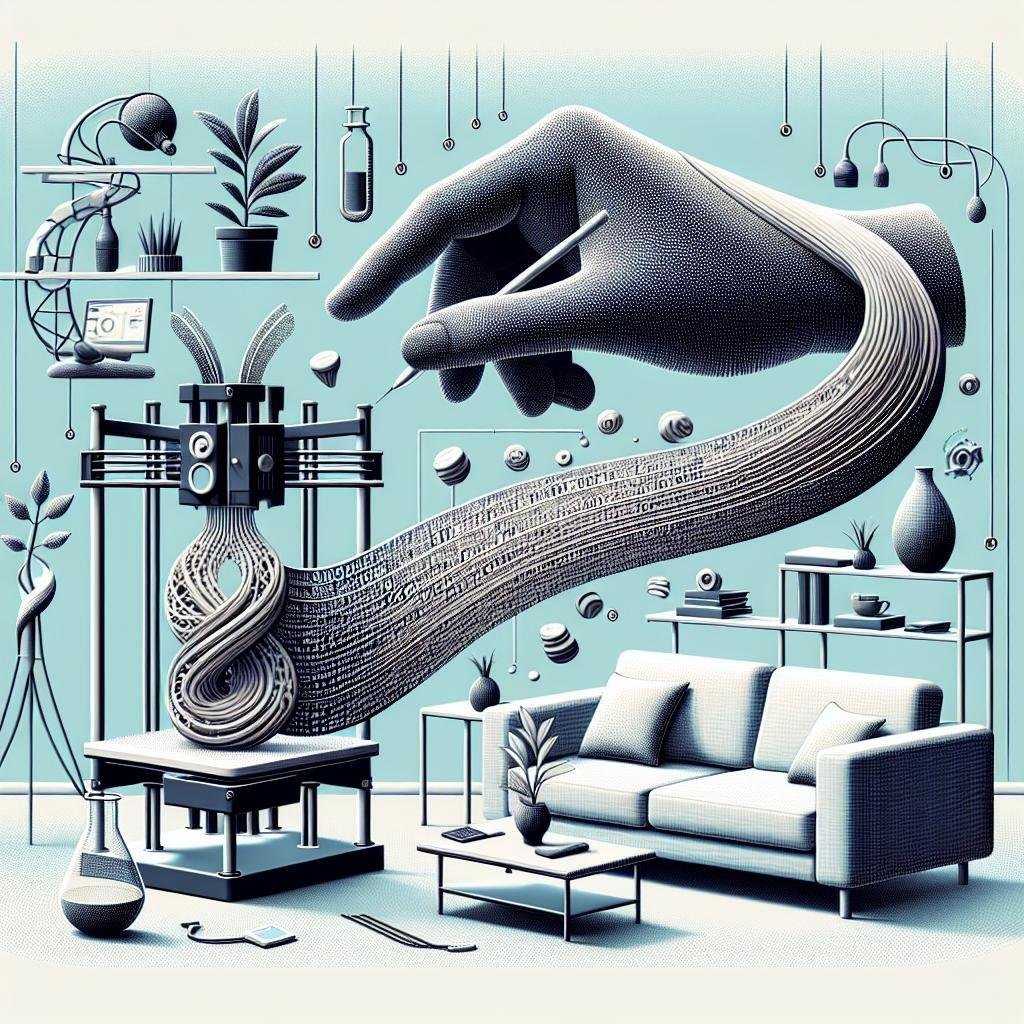Imagine a world where your wildest ideas can leap off the paper and into the palm of your hand. A world where you can sketch a design, refine it with intricate details, and watch as it transforms into a tangible object, layer by layer. This isn’t the premise of a sci-fi movie; it’s the fascinating reality of 3D printing, a technology that is reshaping industries and creative processes worldwide. But behind every beautifully crafted prototype or complex model stands an unsung hero: CAD software.
Computer-Aided Design (CAD) software is the mastermind that turns dreams into digital blueprints, bridging the gap between imagination and creation. Whether you’re an artist, engineer, architect, or hobbyist, understanding how CAD software operates in the realm of 3D printing is key to unlocking its full potential. Join us on a journey through the world of lines and curves, precision and innovation, as we delve into the pivotal role CAD software plays in bringing three-dimensional visions to life.
Creating Seamless Designs: The Backbone of 3D Printing Innovation
Integrating skilled design techniques through Computer-Aided Design (CAD) software is what truly propels the magic of 3D printing. It’s within these digital confines that ideas bloom from ethereal concepts to meticulously detailed blueprints. In crafting seamless designs, CAD software serves as an indispensable tool, offering an array of features like parametric modeling, real-time collaboration, and intricate simulation tests. These sophisticated features enable designers to refine intricate details and simulate real-world functionalities, ensuring that each component is not only aesthetically pleasing but also functionally robust. Imagine the myriad checkpoints – stress tests, material compatibility assessments, and thermal evaluations – all effortlessly executed within the virtual workspace. Such tools drastically reduce wasted resources, allowing for sustainable and efficient rapid prototyping.
The ability to draft intricate mesh structures or tessellated frames highlights CAD software’s prowess in encapsulating the essence of innovative designs. Whether crafting components for biomedical devices, automotive parts, or artistic sculptures, these software platforms allow designers the freedom to play with complex geometries with astonishing precision. Here’s a quick overview of some must-have features in top-tier CAD software:
- User-Friendly Interface: Easily navigable and intuitive for both novices and veterans.
- Real-time Analytics: Immediate feedback on design constraints and material usage.
- Extensive Libraries: A vast repository of pre-made models and textures.
- Responsive Support: Professional assistance and detailed user manuals.

CAD Software Essentials: Elevate Your 3D Printing Game
CAD software is the beating heart of 3D printing, unlocking the potential to bring even the wildest design ideas to life. With powerful design tools at your fingertips, it allows for detailed precision and customization that are crucial for creating intricate models. Whether you’re crafting complex mechanical parts or whimsical art, CAD tools offer a seamless experience from concept to creation. This includes a variety of features such as:
- Parametric design capabilities – Adjust dimensions without altering the entire model.
- Simulation tools – Test how your design will behave under real-world conditions.
- Material estimation – Calculate the amount of material needed for your print.
- Support generation – Automatically design supports for your 3D model.
Understanding and leveraging these tools ensures not only the accuracy of your designs but also optimizes the overall printing process.
| Software | Key Feature | Best For |
|---|---|---|
| Fusion 360 | Cloud collaboration | Team projects |
| SolidWorks | Advanced simulation | Industry professionals |
| TinkerCAD | User-friendly | Beginners |

Mastering Techniques: From Digital Blueprints to Physical Objects
Whether you’re sculpting a fantastical creature or designing a functional mechanical part, mastering computer-aided design (CAD) software is the cornerstone of transforming your imaginative ideas into tangible creations. CAD software equips artists and engineers with a digital canvas to draft and fine-tune their visions. In combining this precision design tool with the realm of 3D printing, a powerful synergy is born. CAD programs offer layers of complexity, allowing users to meticulously adjust dimensions, create realistic textures, and simulate the physics of how an object might interact with its environment. Tools like SolidWorks, AutoCAD, and Fusion 360 have become indispensable in this process, each bringing its own unique strengths. These tools ensure that when your digital blueprint is sent to the 3D printer, the final product mirrors the initial design with unparalleled accuracy.
But the magic doesn’t stop with design. CAD software serves as a bridge between creativity and fabrication by generating the necessary instructions for 3D printers. The software translates your digital models into G-code, a language that 3D printers understand, dictating movements, speed, and layers. This seamless conversion process ensures high fidelity between digital blueprints and the printed objects. Additionally, CAD software often includes features that assist in spotting potential printing issues before they occur. Here are some benefits:
- Error Detection: Identifies and corrects potential design flaws.
- Real-time Adjustments: Modify designs swiftly.
- Material Efficiency: Optimize material usage.
- Cost Prediction: Estimate costs ahead of production.
| CAD Software | Key Feature |
|---|---|
| SolidWorks | Advanced Simulation |
| AutoCAD | Versatile Drafting |
| Fusion 360 | Cloud Collaboration |
This harmonious relationship between digital and physical realms transforms not just how we create, but also how we reimagine the limits of possibility.

Expert Tips: Choosing the Right CAD Tools for Your Projects
Selecting the perfect CAD tool for your 3D printing endeavors can feel like navigating a labyrinth, but here are some expert tips to lighten the way. First, identify your project’s complexity. Tools like SolidWorks or Autodesk Fusion 360 offer advanced features for intricate designs, while simpler projects might only require a user-friendly program like Tinkercad. Simulation capabilities can also be a game-changer, enabling you to catch errors before they become costly print failures. Consider whether your CAD software integrates seamlessly with your 3D printer, as this can save time and reduce headaches.
To help you decide, here’s a concise comparison table of popular CAD tools and their features:
| CAD Tool | Best For | Key Feature |
|---|---|---|
| Tinkercad | Beginners | Ease of Use |
| SolidWorks | Complex Projects | Advanced Simulation |
| Fusion 360 | Medium to Advanced Users | Collaborative Design |
| Blender | Artists | Detailed Sculpting |
Remember: Your choice should align with both the project’s needs and your skill level. If integrating various components or if a collaborative platform is crucial, tools offering these features should be prioritized to streamline your workflow. By tailoring your toolset to your specific needs, you ensure efficiency and higher quality in your 3D prints.
Q&A
Q: What is CAD software and why is it essential for 3D printing?
A: Think of CAD software as the master sculptor of the digital world. CAD stands for Computer-Aided Design, and it’s the tool that allows creators to design precise models on a computer before they’re brought to life via 3D printing. Just like an artist needs a canvas, a 3D printer needs a digital blueprint, which is crafted using CAD software.
Q: Can someone with no prior experience start using CAD software, or is it too complicated?
A: Absolutely! While CAD software can seem intimidating at first glance, there are user-friendly versions tailored for beginners. It’s akin to learning to ride a bike; once you get the hang of it, you’ll start to enjoy the ride and discover its potential. Plenty of tutorials and communities out there can also lend you a helping hand as you start your CAD journey.
Q: How does CAD software enhance the 3D printing process?
A: CAD software is like the conductor of an orchestra, ensuring that everything is in perfect harmony. It allows you to tweak, adjust, and perfect your design down to the minutest detail. This precision ensures that your 3D print is just right—no wobbly parts or awkward fits. Moreover, it can simulate how your design will look and behave in the real world, saving you time and material in the trial-and-error phase.
Q: What features should I look for in CAD software for 3D printing?
A: Great question! When choosing CAD software, look for features like ease of use, a robust library of pre-designed elements, compatibility with your 3D printer, and powerful editing tools. Advanced options might include simulation tools, which predict how your printed object will behave under stress, and parametric design capabilities, allowing you to adjust dimensions easily without starting from scratch.
Q: Are there any popular CAD software options specifically for 3D printing?
A: Definitely. Some of the rock stars in the CAD software galaxy include Tinkercad, which is great for beginners, and Autodesk Fusion 360, known for its powerful features and professional capabilities. For the open-source enthusiasts, there’s FreeCAD, offering robust functionality without a hefty price tag.
Q: How do CAD software and 3D printing work together in industries like healthcare and fashion?
A: In healthcare, CAD software is a miracle worker, helping design custom prosthetics, dental implants, and even complex structures like heart valves. It ensures that these critical components are a perfect fit for individual patients.
In fashion, it’s like having your personal designer at your fingertips. CAD enables the creation of intricate patterns and designs that can be brought to life with 3D printing, pushing the boundaries of what’s possible in haute couture and accessories.
Q: What’s the future of CAD software in the realm of 3D printing?
A: The future’s looking bright and tech-savvy! We can expect more intuitive interfaces, making it accessible even for folks with no technical background. AI and machine learning might step in, offering design suggestions based on past projects. Additionally, further integration with virtual and augmented reality could make the design process even more immersive and interactive.
So, whether you’re a novice or a seasoned designer, CAD software opens up a world of creativity and precision, paving the way for your 3D printing dreams to come true. Dive in and start designing—your next masterpiece awaits!
Future Outlook
As we journey through the vibrant intersection of creativity and technology, it’s clear that CAD software plays an indispensable role in the world of 3D printing. It’s the silent composer in the background, orchestrating the symphony that turns digital blueprints into tangible, hold-in-your-hand creations.
So, whether you’re an intrepid pioneer in the realm of design or a curious newcomer, remember that every masterpiece starts with a single, well-drawn line. Keep exploring, keep creating, and let the wonders of CAD and 3D printing unlock the doors to your imagination.
Until next time, happy designing and printing! 🛠️✨

